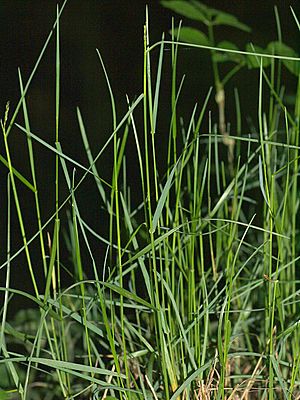Wood bluegrass facts for kids
Quick facts for kids Wood bluegrass |
|
|---|---|
 |
|
| Scientific classification | |
| Genus: |
Poa
|
| Species: |
nemoralis
|
| Synonyms | |
|
Agrostis alba L. |
|
Poa nemoralis, also known as the wood bluegrass, is a type of plant that lives for many years (a perennial). It belongs to the Poaceae family, which is the grass family. This grass grows later in the season and is quite good for animals to eat, especially in the autumn. People also use it as a lawn grass in places that are shady.
What Wood Bluegrass Looks Like
Wood bluegrass grows in loose clumps. It looks more delicate and thin compared to other grasses you might see in meadows. It spreads out slowly along the ground.
Its leaves are narrow and become pointy at the end. The small flap at the base of the leaf, called a ligule, is very short, about 0.5 millimeters. The stem of the plant is thin and usually grows to be about 30 to 60 centimeters (about 1 to 2 feet) tall.
The flowers grow on a thin, loose, and branched structure called a panicle. The small flower clusters, called spikelets, are few and shaped like an egg. Each spikelet has one to five tiny flowers. This grass usually flowers from June to August in the Northern Hemisphere.
This plant can make seeds without needing another plant (this is called apomixis). It can also spread and grow new plants from its stems, which is a way of reproducing without seeds.
In Germany, because of its unique leaf shape that looks like a stretched-out arm, it is sometimes called "Wegweisergras," which means "signpost grass."
Where Wood Bluegrass Grows
Wood bluegrass is originally from Europe, where it can be found from Portugal all the way to Bulgaria. It also grows in Asia, from Iran to Japan.
This grass has been brought to other parts of the world, like Australia, New Zealand, and North America. In southeastern Canada and the northeastern United States, it has started to grow naturally.
Wood bluegrass can grow well in the shade, so you often find it in forests. It can reach up to half a meter tall. In Britain, it commonly grows in dry woods, thickets, and shady areas near hedges, especially in soil that drains well.
In places where it has been introduced, like some parts of America, it sometimes grows in pine forests. When it grows there, it might make the forest more likely to catch fire. You can also find it on floodplains, along the banks of rivers and lakes, and in disturbed areas where the ground has been moved or changed. In the British Isles, it is found all over the United Kingdom, but in Ireland, it is found in fewer places, suggesting it might have been brought there by people.
See also
 In Spanish: Poa nemoralis para niños
In Spanish: Poa nemoralis para niños

